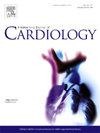Trajectory, correlates, and outcomes of pulmonary congestion by lung ultrasound in patients hospitalized for acute pulmonary edema
IF 3.2
2区 医学
Q2 CARDIAC & CARDIOVASCULAR SYSTEMS
引用次数: 0
Abstract
Aims
Patients with acute pulmonary edema (APE) requiring an urgent heart failure (HF) hospitalization face poor prognosis largely due to pulmonary congestion. We aimed at assessing the patterns and variations of pulmonary congestion associated with different assessments of congestion and prognosis.
Methods
This prospective study included patients with APE who underwent lung ultrasound (8-zone B-lines method) and echocardiography immediately after emergency department visit, with follow-up assessments on days 2, 3, 7, and discharge. B-type natriuretic peptide (BNP) levels were measured at admission, day 7, and discharge. The associations between B-line changes, other congestion marker changes and outcomes were assessed.
Results
Among 137 patients (mean age: 77 ± 13 years; 61 % male), 71 % had New York Heart Association IV, 65 % had left ventricular ejection fraction <45 %, and median B-lines were 44 (32–58) on admission. While B-lines showed no association with other congestion markers at admission, they correlated significantly with pulmonary artery systolic pressure (PASP) from day 2 to discharge, and with E/e´ and BNP at day 7 and discharge. Throughout hospitalization, B-line changes consistently correlated with changes in other congestion markers (E/e´, PASP, and BNP) (all-p-values<0.05). Among congestion markers, B-lines showed the most prominent reduction from admission to day 2, and this reduction was associated with a lower risk of all-cause mortality or HF rehospitalization over a median 217-day follow-up (adjusted-HR, 95 %CI = 0.96, 0.94–0.99; p = 0.01).
Conclusions
In APE, B-lines lacked association with other congestion markers immediately after hospitalization. However, B-lines decreased noticeably from admission to day 2, with changes correlating with other markers and prognosis.
急性肺水肿住院患者肺部超声诊断肺充血的轨迹、相关因素和结果。
目的:急性肺水肿(APE)患者需要紧急心力衰竭(HF)住院治疗,其预后不良主要是由于肺充血。我们的目的是评估与不同的充血评估和预后相关的肺充血模式和变化。方法:这项前瞻性研究纳入了在急诊科就诊后立即进行肺部超声(8区b线法)和超声心动图检查的APE患者,并在第2、3、7天和出院时进行随访评估。在入院、第7天和出院时测量b型利钠肽(BNP)水平。评估了b线变化、其他拥堵标志变化与结果之间的关系。结果:137例患者(平均年龄:77 ± 13 岁;61 %男性),71 %有纽约心脏协会IV, 65 %有左心室射血分数结论:在APE中,b系与住院后立即出现的其他充血指标缺乏关联。然而,b线从入院到第2天明显下降,其变化与其他标志物和预后相关。
本文章由计算机程序翻译,如有差异,请以英文原文为准。
求助全文
约1分钟内获得全文
求助全文
来源期刊

International journal of cardiology
医学-心血管系统
CiteScore
6.80
自引率
5.70%
发文量
758
审稿时长
44 days
期刊介绍:
The International Journal of Cardiology is devoted to cardiology in the broadest sense. Both basic research and clinical papers can be submitted. The journal serves the interest of both practicing clinicians and researchers.
In addition to original papers, we are launching a range of new manuscript types, including Consensus and Position Papers, Systematic Reviews, Meta-analyses, and Short communications. Case reports are no longer acceptable. Controversial techniques, issues on health policy and social medicine are discussed and serve as useful tools for encouraging debate.
 求助内容:
求助内容: 应助结果提醒方式:
应助结果提醒方式:


